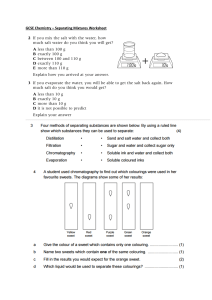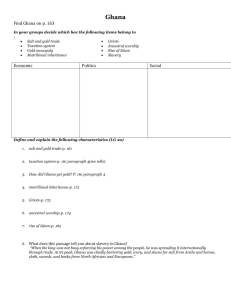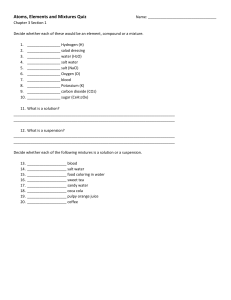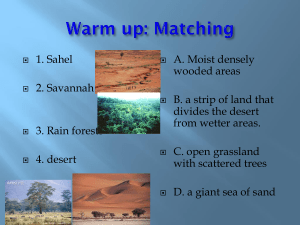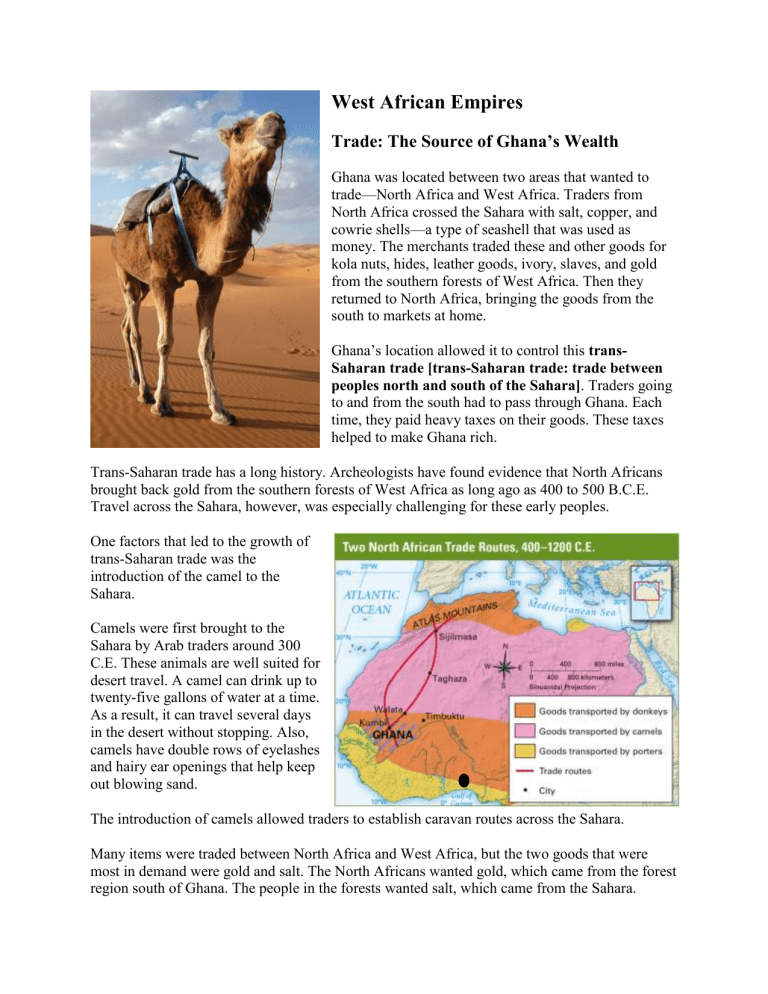
West African Empires Trade: The Source of Ghana’s Wealth Ghana was located between two areas that wanted to trade—North Africa and West Africa. Traders from North Africa crossed the Sahara with salt, copper, and cowrie shells—a type of seashell that was used as money. The merchants traded these and other goods for kola nuts, hides, leather goods, ivory, slaves, and gold from the southern forests of West Africa. Then they returned to North Africa, bringing the goods from the south to markets at home. Ghana’s location allowed it to control this transSaharan trade [trans-Saharan trade: trade between peoples north and south of the Sahara]. Traders going to and from the south had to pass through Ghana. Each time, they paid heavy taxes on their goods. These taxes helped to make Ghana rich. Trans-Saharan trade has a long history. Archeologists have found evidence that North Africans brought back gold from the southern forests of West Africa as long ago as 400 to 500 B.C.E. Travel across the Sahara, however, was especially challenging for these early peoples. One factors that led to the growth of trans-Saharan trade was the introduction of the camel to the Sahara. Camels were first brought to the Sahara by Arab traders around 300 C.E. These animals are well suited for desert travel. A camel can drink up to twenty-five gallons of water at a time. As a result, it can travel several days in the desert without stopping. Also, camels have double rows of eyelashes and hairy ear openings that help keep out blowing sand. The introduction of camels allowed traders to establish caravan routes across the Sahara. Many items were traded between North Africa and West Africa, but the two goods that were most in demand were gold and salt. The North Africans wanted gold, which came from the forest region south of Ghana. The people in the forests wanted salt, which came from the Sahara. Ghana made most of its money from the taxes it charged on the gold-salt trade that passed through its lands. Wangara: The Secret Source of Gold Gold has long been a source of wealth in much of the world. In the time of Ghana’s empire, people in Muslim lands and in Italy made coins from gold. Muslims also needed gold to purchase silk and porcelain from China, which would accept only gold in exchange. In an area known as Wangara, gold was plentiful. Wangara was located near the forests south of present-day Ghana, but no one except the people of Wangara knew its exact location. The Wangarans kept the locations of their gold mines secret. According to ancient stories, merchants occasionally captured a gold miner and tried to force him to reveal the location of Wangara. The miners would give up their lives rather than reveal the secret. In one story, after the capture of a miner, the Wangarans stopped trading for three years. They wanted to make sure no one had discovered Wangara’s location. To this day, no one knows for certain exactly where Wangara’s mines were located. Current map of African countries. Taghaza: A Village Built with Salt To West Africans, salt was more precious than gold. Their culture had little use for gold, except as an item for trade. But they craved salt, and for good reason. Salt is an important part of a person’s diet. When people and animals perspire, or sweat, they lose salt in their perspiration. People who live in hot climates, like West Africa, perspire a lot and must replace the salt they lose. West Africans also needed salt to keep their food from spoiling and to give to their cattle. In addition, people liked the taste. West Africans had no local source of salt. They had to obtain it from Taghaza and other places in the Sahara. Salt was produced in two ways in the Sahara. One method was through evaporation [evaporation: the process in which a liquid, such as water, turns into a gas] . Water was poured into holes in the salty earth. The water slowly drew out the salt and then evaporated in the sun. The salt that remained was scooped out and packed into blocks. The second way to get salt was through mining. At Taghaza, salt deposits were found about three feet below the surface of the earth. Miners, enslaved by Arab merchants, reached the salt by digging trenches and tunnels. Then they cut it out in large blocks. Taghaza would not have existed without salt. It was a dismal place, without crops or vegetation. People lived there for one purpose only: to mine and sell salt. Even the houses and mosque were built of salt blocks. Trade caravans passed through Taghaza on their way through the Sahara. There, they picked up salt to sell in Ghana and the southern forests. Because no food was produced in Taghaza, the miners had to rely on caravans to bring food, such as camel meat, dates, and a type of grain, called millet. If the caravans didn’t come, the miners starved. The Quiet Exchange of Goods . Even Today, salt is an important trade item in West Africa. When trade caravans entered Ghana, they brought their goods to the great marketplace in the capital city of Kumbi. From there, they headed to the southern forests to trade with the Wangarans. Kumbi had the busiest market in West Africa. Many local crafts-people sold their goods there. Ironsmiths sold weapons and tools. Goldsmiths and coppersmiths sold jewelry. Weavers sold cloth, and leatherworkers sold leather goods. There were blue blouses from Spain and robes from Morocco, in North Africa. People could also buy cattle, sheep, honey, wheat, raisins, dried fruit, ivory, pearls, and slaves. All goods, including slaves, were paid for with gold dust. Kumbi had one of the largest slave markets in West Africa. The slaves were captured by raiders along the southern border of Ghana. Many were bought at Kumbi by Arab merchants, who took them across the Sahara and sold them to North Africans or Europeans. Trade with the Wangarans took place along a river in the southern forests. Traders carried out their business using a system of silent barter, or trade. The caravans arrived bringing wool, silk, cotton, dates, figs, grains, leather, and salt. They spread out their goods along the river. The traders beat on a drum to announce that they were making an offer to trade. Then they walked several miles away from the site. When the Wangarans heard the drum, they traveled to the site by boat. They put some gold dust next to the goods, beat a drum, and left. Later, the traders returned. If the amount of gold dust was acceptable, they took it and left. If not, they went away again and waited for the Wangarans to return and leave more gold dust. The groups bargained back and forth in this way without ever meeting in person. This system of silent barter had two advantages. First, it allowed people who spoke different languages to trade. Second, it allowed the Wangarans to protect the secret location of their gold mines.
